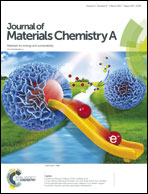A facile and green synthesis of colloidal Cu2ZnSnS4 nanocrystals and their application in highly efficient solar water splitting†
Abstract
The development of solution-processable routes as well as compounds consisting of earth abundant elements is highly desirable to reduce the fabrication cost. Recently, kesterite Cu2ZnSnS4 (CZTS) nanocrystals (NCs) have attracted great attention for photoelectrochemical (PEC) water splitting owing to their suitable low-cost, earth-abundancy and suitable band gap energy. However, the environmentally benign synthesis of high-quality CZTS NCs without toxic solvents remains elusive. Here, a green chemistry approach employing vegetable oil as a non-toxic solvent for the synthesis of monodisperse and size-tunable CZTS NCs is introduced for the first time. Additionally, the relationship between the abnormal size behavior of the CZTS NCs and the degree of decomposition in the vegetable oil using electrospray ionization mass spectrometry (ESI-MS) measurements is elucidated for the first time. As a conceptual strategy, a ternary abundant compound based heterojunction nanostructure for efficient solar water splitting by introducing CZTS NCs onto 5 nm Zn(O,S) passivated layer/hydrothermally grown TiO2 nanorod arrays (TNRs) is designed and developed. Remarkably, this ternary CZTS NCs/Zn(O,S)/TNR photoelectrode shows a photocurrent density as high as 15.05 mA cm−2 at 1.23 V (vs. the NHE), which is the highest ever for previously reported CZTS NC-based photoelectrodes. The reasons for the enhanced PEC performance are discussed in detail based on different PEC characterizations. More importantly, this work reflects the sophistication of eco-friendly solution phase synthesized CZTS NCs without using any toxic chemicals as an earth abundant sensitizer and constitute a new paradigm towards the enhanced PEC performance with quantum dot based hetero-nanostructures.


 Please wait while we load your content...
Please wait while we load your content...